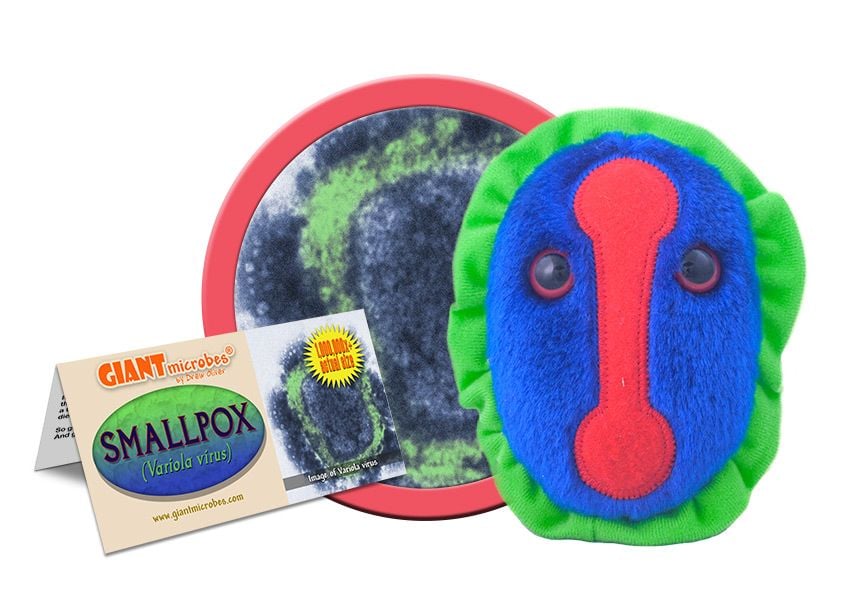Smallpox (Variola virus)
Makes a great tool for students of all ages to learn about science, history and how humankind can solve huge problems!
Product Details
Additional Information
| Sizes | Giantmicrobes are based on actual microbes, cells, organisms and other critters, only 1,000,000 times actual size! Gigantic (GG) 40-60cm XL (XL) 25-38cm Original (PD) 12-20cm Minis (MM) 5-10cm each Keychain (KC) 5-10cm with clip |
|---|---|
| Materials | Plush from all new materials. Stuffed with polyester fiber fill. Surface washable: sponge with water & soap, air dry. |
| Packaging | Each plush microbe includes a printed card with fun, educational and fascinating facts about the actual microbe or cell. |
| Safety | Every product meets or exceeds U.S. and European standards for safety. For ages 3 and up. |
All about Smallpox (Variola virus)
FACTS: Smallpox is a deadly disease caused by the variola virus. From ancient Egypt and Greece, to China and the Americas, it has killed countless millions for centuries. Smallpox arrived in the New World with Columbus and Cortes, and it devastated Native American populations who had no immunities to the virus. The disease played a major role in the conquest of Mexico and Peru, as well as the European settlement of North America. In India there is even a goddess of smallpox, Sitala. Her name means “the cool one.” If you are a virologist, perhaps you might think variola is pretty cool. But rest assured, smallpox is a lethal disease that has played no small part in human history.
Variola is one of the largest and most complicated viruses known. It invades a human cell and forces it to reproduce the virus until there are thousands of viruses inside the cell. The cell bursts and showers the virus onto other cells. The disease is horrible, causing high fever, red pus-filled blisters and oozing sores.
It is transmitted very quickly by a cough or a sneeze. Infection occurs by inhaling these airborne particles or by touching contaminated clothing. As recently as 1967, 15 million people contracted smallpox. Thankfully one of modern medicine’s true triumphs has been smallpox’s eradication. In 1980, after a global campaign of vaccinations and surveillance, the World Health Organization made an astonishing announcement: smallpox is dead. Today the smallpox virus only exists frozen in laboratories where it can be studied. There is still no known cure...
| Name | Smallpox is caused by the variola virus which means “spotted” in Latin. This is because small, raised bumps break out all over the faces and bodies of those affected. |
|---|
| Actual Size | 200-400 nanometers. |
|---|
| Where It Lives | Variola enters through the respiratory tract and through either the mouth, trachea, or lungs as it makes its way to a host cell. Then, it can be replicated throughout the body. |
|---|
| Symptoms | The first phase of infection causes high fevers and body aches. After a few days, it progresses to a rash of small red spots on the tongue and mouth of the victim. After a week, this small rash escalates to full blown sores on the face, arms, legs, and eventually hands and feet. Then these sores scab over if the infected person has survived for that long. |
|---|
| Cure | Edward Jenner noticed that milkmaids infected with cowpox were asymptomatic to smallpox. Dr. Jenner took material from a cowpox sore and inoculated it into his gardener’s son, James Phipps’ arm. Months later, Jenner exposed Phipps a number of times to the smallpox virus, but Phipps never developed the disease. This is how the cure to smallpox was created and potentially saved millions of lives. |
|---|
| Deadliness/Severity | Vaccination is now available, but it used to kill an average of three out of every ten people infected. Those who survived were left severely and painfully scarred all over their bodies. |
|---|
| Infectiousness | Highly contagious and can spread through saliva droplets in a person’s breath. This virus is only infectious for a short period of time after a fever has developed. |
|---|
| History |
A potential smallpox rash was found on three mummies from the Egyptian Empire in the 3rd century. The growth and spread of civilization and increase in trade can be linked to smallpox outbreaks. In 1633 smallpox wiped out over seventy percent of the Native American population. Overall, smallpox has taken approximately 300-500 million lives. Finally, in 1796, Edward Jenner developed a vaccine for this killer disease. |
|---|
| Fascinating Facts |
Many religions have Gods and Goddesses of smallpox. For example, in the Hindu religion, Sitala Mata was worshipped in hopes of eliminating the virus. The smallpox vaccine was the first vaccine ever invented. The word vaccine actually has the Latin root for cow, “vacca”, because it was cowpox that was used to eradicate smallpox. |
|---|












